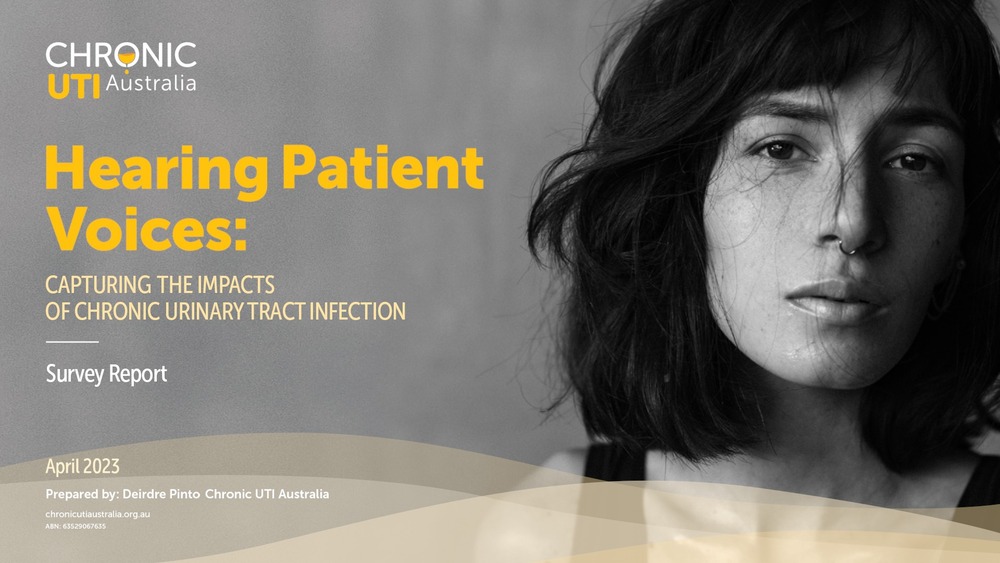
Chronic UTI Survey Report – Hearing Patient Voices
The Hearing Patient Voices project surveyed 410 people from around the world with chronic urinary tract infection (UTI). The online survey measured the impact chronic UTI has on quality-of-life and focused on symptoms, various life domains, emotional wellbeing, healthcare experiences and avoidable costs to the health system. You can read a summary, and download the full Hearing Patient Voices survey report, below.
Breaking the Silence: Key Findings from the Hearing Patient Voices Survey
Chronic urinary tract infections (UTI) are affecting a growing number of people across Australia and the rest of the world. Despite this, chronic UTI is not well understood, and little research has been conducted on the experiences of people living with the condition.
At Chronic UTI Australia, we are advocating for better testing, diagnosis and treatment of all forms of urinary tract infection. We wish to raise awareness to the growing number of people who are developing chronic, embedded bladder infections due to current testing and treatment failures.
The Hearing Patient Voices Survey
To gain more insight into the impacts of chronic UTI on individuals, the health system and society at large, Chronic UTI Australia conducted the Hearing Patient Voices survey. The survey raises critical awareness of this neglected health condition and the detrimental impact it has on those who suffer, mostly in silence. It provides valuable insights into the challenges faced by chronic UTI patients (including their symptoms, diagnosis and treatment) and highlights the need for better education, testing and treatment options.
Participant demographics
Conducted between late 2021 and early 2022, the online survey attracted 410 respondents from around the world. While most of the patients were Australian based (40.2%), the survey also represented many other countries including the United Kingdom (28.3%), United States (14.3%), Canada (3.6%) and Ireland (2.7%).
The age of participants ranged from 19 to 84 years, with an average patient age of 46.7 years. A vast majority of respondents identified as female (96.5%), with 2.7% identifying as male and 0.7% identifying as non-binary or gender diverse. Most participants (80%) had been diagnosed with a chronic UTI by a health professional at the time of the survey.
More information about participant demographics can be found on pages 12-13 of the full report.
Key themes
Four key themes emerged from the survey data, reflecting the greatest impacts for people living with chronic UTI:
- Long-term impact on quality-of-life: Respondents reported suffering serious quality-of-life impacts, for years and sometimes decades. Many reported depression and anxiety due to the physical, emotional and social effects of living with chronic UTI.
- Poor healthcare experiences seeking help: The survey highlighted health professionals’ lack of understanding of, and ability to diagnose and treat chronic UTI, compounded participants distress. Most respondents reported poor treatment in the health system.
- Misdiagnoses and treatment failures: The inaccuracy of current UTI testing (including urine cultures) is resulting in misdiagnosis and underdiagnosis of UTIs. This is causing delayed treatment, worsening symptoms and often results in ineffective, potentially harmful, treatments.
- Costs to the healthcare system: Participants, as chronic UTI sufferers, had a much higher rate of health service utilisation than that of the general population. This is resulting in avoidable costs to the healthcare system.
Chronic UTI symptoms
The Hearing Patient Voices survey found that chronic UTI patients experience a wide range of symptoms that can impact their daily lives. More than 90% of participants struggled with urinary frequency, leaving some housebound or unable to sleep. Other common chronic UTI symptoms reported included:
- cloudy, bloody or smelly urine (80.7%)
- bladder fullness (79.5%)
- overactive bladder (74.6%)
- voiding symptoms (72.7%)
- stress urinary incontinence (42%)
Nearly all (97.6%) of our sample reported pain as one of their chronic UTI symptoms. The average rating of pain associated with chronic UTI symptoms was 7.9 out of ten, indicating pain in the upper range between ‘very intense’ and ‘utterly horrible’. Nearly half of respondents (47.8%) rated their worst pain between 9-10 out of ten, between ‘excruciating, unbearable’ and ‘unimaginable, unspeakable’.
More information on chronic UTI symptoms can be found on page 20 of the full report.
Long-term impact on quality-of-life
Despite the prevailing belief that UTIs are trivial and easily treated, chronic UTI can be an extremely painful and debilitating condition. This condition limits daily activities, such as exercise work, sleep, sexual function and intimacy, while contributing to depression and anxiety.
More than 9 in 10 people said their overall quality-of-life had been negatively impacted by their chronic UTI and nearly half described the impact as ‘extreme’. The most heavily impacted life domains were:
- the ability to have a happy sex life (83%)
- feeling good about yourself (77.1%)
- maintaining good mental and emotional health (74.7%)
- the ability travel for leisure or work (72.8%)
- the ability to exercise (72.1%)
- sleeping (71.5%)
Our participants also had significantly worse mental health scores than the general population. Half of participants sampled had mental health component summary scores ‘well below’ the population norms and another 20% ‘below’ the norm. One in ten participants disclosed that the condition had left them feeling suicidal or they had planned or attempted to take their own lives because of the condition.
More information on quality-of-life impacts can be found on pages 29-30 and pages 42-43 of the full report.
Poor healthcare experiences seeking help
The distress caused by chronic UTI symptoms is often compounded by health professionals’ lack of understanding and ability to diagnose and treat the condition. More than 80% of participants agreed, or strongly agreed, that it had been difficult to find a healthcare practitioner who understands and can treat chronic UTI.
- 81.9% agreed, or strongly agreed, their symptoms had been dismissed or not believed by a healthcare professional.
- 51.7% reported experiencing negative interactions with doctors, with more than eight in ten reporting feeling ‘belittled’ or ‘disbelieved’.
- 76.8% had been given unhelpful advice to change their behaviour (e.g being told to drink more water, consume cranberry products, or be more hygienic).
Even though 92.7% had returned a negative urine culture test while experiencing UTI symptoms, only 39.5% had been told by a doctor about the diagnostic inaccuracies of urinary dipsticks and urine cultures. This often meant participants were denied appropriate antibiotic treatment, despite having clinical symptoms and a personal history consistent with UTI.
Many participants reported that health professionals’ frequent lack of understanding that UTI tests can be inaccurate, and lack of awareness of chronic UTI, had led to misdiagnosis and ineffective, potentially harmful, medical and surgical treatments.
Misdiagnoses and treatment failures
Due to the proven deficiencies of UTI tests and poor understanding of chronic UTI among health professionals, almost two thirds of participants (62.2%) had received alternative diagnoses to explain their UTI symptoms:
- Interstitial Cystitis/Painful Bladder Syndrome (55.1%)
- Recurrent UTI (26.6%)
- Mental health diagnosis (17.3%)
- Pelvic floor dysfunction (17.3%)
More than two thirds of participants (67.1%) had been offered or given therapies they believed were inappropriate, ineffective or unhelpful, and about two thirds (64.4%) had been told nothing could be done for their symptoms. This lack of chronic UTI knowledge among healthcare providers has led to many sufferers being forced to seek a diagnosis and treatment from specialist clinics abroad.
More information on participants’ experiences seeking help for chronic UTI symptoms can be found on page 32-35 and page 44 of the full report.
Costs to the healthcare system
Chronic UTI is causing a high level of potentially avoidable expenditure to the healthcare system. Survey participants had much higher health service utilisation than the general population. This was most pronounced for resource intensive services such as medical specialists, hospitalisations and emergency department visits. Survey participants were about three times more likely than the general population to be admitted to hospital or to have seen three or more health professionals in the previous 12 months.
More information on costs to the healthcare system can be found on page 36 and 45 of the full report.
Next steps
Individuals with chronic UTI endure a great deal of unnecessary and preventable suffering. As one of several health conditions predominantly affecting women, Chronic UTI is neglected in medical research and practice. While conditions such as endometriosis and pelvic mesh injury are finally getting the attention they deserve, chronic UTI remains poorly recognised and treated.
The Hearing Patient Voices survey reveals that the distress caused by painful and life-altering physical symptoms that can persist for many years, even decades. This is further exacerbated by inadequate understanding and mismanagement by professionals in the healthcare system.
Until now, the personal, financial and emotional impacts associated with this condition have been grossly underestimated and underreported. To address this growing health issue, there is an urgent need for collaboration among policy makers, healthcare professionals, researchers and patient groups to prioritise:
- education and resources for health professionals, including new professional guidelines.
- education of the public, especially high-risk groups such as young women.
- specialist clinics dedicated to chronic and complex UTI presentations.
- research funding to deliver reliable diagnostic methods and safer, faster effective treatments for UTI.
More information on the next steps can be found on page 46 of the full report.
The Hearing Patients Voices survey was funded by our sponsors
Along with a community grant from



